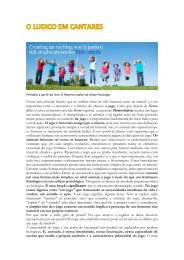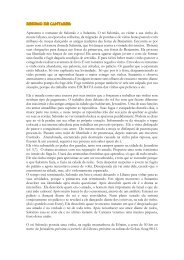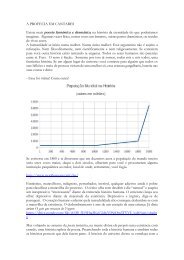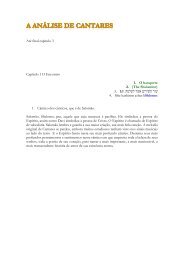Motherhood in Childhood
Create successful ePaper yourself
Turn your PDF publications into a flip-book with our unique Google optimized e-Paper software.
this often-overlooked group’s unique needs,<br />
vulnerabilities and challenges.<br />
At the ICPD, governments across the globe<br />
recognized the special needs of adolescents and<br />
youth and the unique barriers they face <strong>in</strong> access<strong>in</strong>g<br />
quality reproductive health <strong>in</strong>formation and<br />
services. Participat<strong>in</strong>g governments agreed to<br />
remove regulatory, legal, and social barriers that<br />
<strong>in</strong>hibit adolescents’ access to services. They also<br />
agreed that health services must safeguard the<br />
rights of adolescents to privacy and confidentiality,<br />
employ<strong>in</strong>g the evolv<strong>in</strong>g capacities standard<br />
for autonomous decision-mak<strong>in</strong>g.<br />
4 Ensure adolescents’ access<br />
to comprehensive sexuality<br />
education, services and maternal<br />
health care<br />
Expand access to comprehensive sexuality<br />
education<br />
Age-appropriate, comprehensive sexuality education<br />
provides adolescents with vital <strong>in</strong>formation<br />
about prevent<strong>in</strong>g pregnancy and sexually transmitted<br />
<strong>in</strong>fections, <strong>in</strong>clud<strong>in</strong>g HIV, and can promote<br />
gender equality. The ICPD global survey shows<br />
that about 76 per cent of countries were committed<br />
to age-appropriate sexuality education, about<br />
70 per cent were committed to revis<strong>in</strong>g curricula<br />
to make them more gender-sensitive and 69<br />
per cent supported life-skills tra<strong>in</strong><strong>in</strong>g for young<br />
people through formal education. Increas<strong>in</strong>g<br />
access to age-appropriate comprehensive sexuality<br />
education—so that it reaches boys and girls and<br />
adolescents who are <strong>in</strong> or out of school, <strong>in</strong>clud<strong>in</strong>g<br />
those from <strong>in</strong>digenous peoples and ethnic m<strong>in</strong>orities—would<br />
contribute to improved health of girls<br />
and boys, promote equitable gender relations, help<br />
prevent pregnancy, and <strong>in</strong> turn help girls rema<strong>in</strong><br />
<strong>in</strong> school and realize their full potential.<br />
Strengthen gender equality and rights<br />
aspects of the curriculum<br />
Research shows that the comprehensive sexuality<br />
education programmes that have had<br />
the greatest impact on reduc<strong>in</strong>g adolescent<br />
pregnancy and sexually transmitted <strong>in</strong>fections<br />
were those that addressed gender and<br />
power issues (Haberland and Rogow, 2013).<br />
Studies show that young people who believe<br />
<strong>in</strong> gender equality have better sexual health<br />
outcomes than their peers (International<br />
Sexuality and HIV Curriculum Work<strong>in</strong>g<br />
Group, 2011).<br />
Comprehensive sexuality education<br />
should therefore address issues of gender<br />
and rights <strong>in</strong> a mean<strong>in</strong>gful way. Young<br />
people who, compared to their peers, adopt<br />
egalitarian attitudes about gender roles<br />
are more likely to delay sexual debut, use<br />
condoms, and practice contraception; they<br />
also have lower rates of sexually transmitted<br />
<strong>in</strong>fections and un<strong>in</strong>tended pregnancy<br />
(Dupas, 2011).<br />
In addition, sexuality education is more<br />
likely to be effective <strong>in</strong> protect<strong>in</strong>g adolescents’<br />
health and prevent<strong>in</strong>g pregnancy if it<br />
is age-appropriate, comprehensive, based on<br />
evidence and core values and human rights,<br />
gender-sensitive, promotes academic growth<br />
and critical th<strong>in</strong>k<strong>in</strong>g, fosters civic engagement,<br />
and is culturally appropriate.<br />
The picture, however, rema<strong>in</strong>s sober<strong>in</strong>g<br />
with regard to reach<strong>in</strong>g marg<strong>in</strong>alized<br />
adolescents, <strong>in</strong>clud<strong>in</strong>g those liv<strong>in</strong>g <strong>in</strong><br />
extreme poverty and married girls. Very<br />
few programmes reach these groups, especially<br />
adolescents who are not <strong>in</strong> school.<br />
Develop<strong>in</strong>g out-of-school programmes is<br />
therefore essential.<br />
88 CHAPTER 5: CHARTING THE WAY FORWARD

















